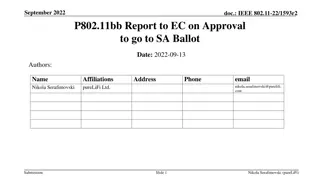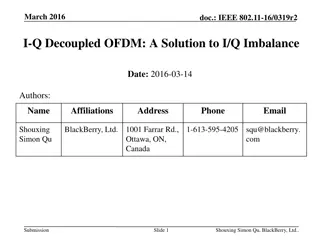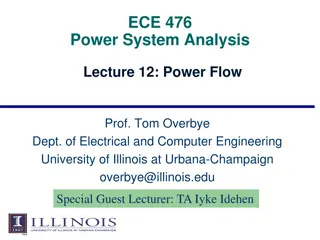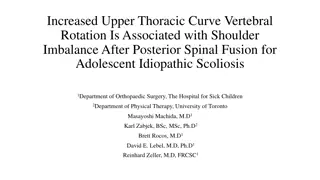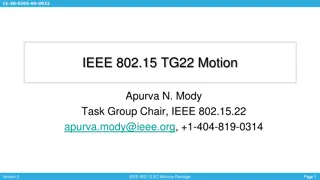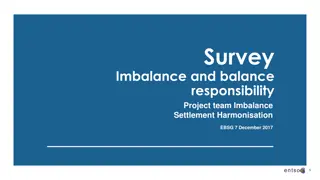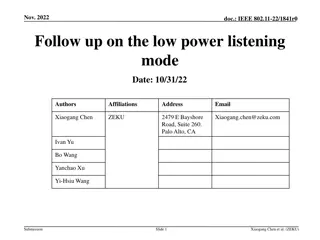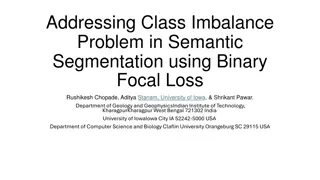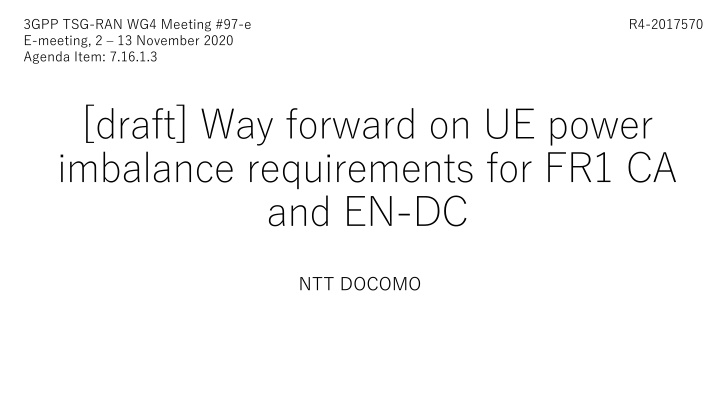
UE Power Imbalance Requirements for FR1 CA and EN-DC
Explore the way forward on UE power imbalance requirements for Frequency Range 1 (FR1) Carrier Aggregation (CA) and Enhanced Non-Standalone (EN-DC) technology with insights from recent 3GPP meetings. Delve into testing methodologies, demodulation requirements, and channel bandwidth combinations. Navigate through test applicability rules and considerations for LTE and NR carriers in the latest developments for efficient network operations.
Download Presentation

Please find below an Image/Link to download the presentation.
The content on the website is provided AS IS for your information and personal use only. It may not be sold, licensed, or shared on other websites without obtaining consent from the author. If you encounter any issues during the download, it is possible that the publisher has removed the file from their server.
You are allowed to download the files provided on this website for personal or commercial use, subject to the condition that they are used lawfully. All files are the property of their respective owners.
The content on the website is provided AS IS for your information and personal use only. It may not be sold, licensed, or shared on other websites without obtaining consent from the author.
E N D
Presentation Transcript
3GPP TSG-RAN WG4 Meeting #97-e E-meeting, 2 13 November 2020 Agenda Item: 7.16.1.3 R4-2017570 [draft] Way forward on UE power imbalance requirements for FR1 CA and EN-DC NTT DOCOMO
Background: WF in previous meeting RAN4 # 95-e WF: R4-2008848 RAN4 # 96-e WF: R4-2012691 2
Wayforward For FR1 intra-band contiguous CA MCS 2Rx: MCS 26 4Rx: MCS 27 Test applicability rule Reuse the following applicability rule from LTE CA power imbalance test (CTC, HW, E///, CMCC, Intel) For FDD or TDD CA power imbalance tests, if they are tested with FDD or TDD intra-band contiguous CA configurations with 2 DL CCs, the test coverage can be considered fulfilled with FDD or TDD intra- band contiguous CA configurations with 3 or more DL CCs supported by the UE. For FDD or TDD 2 DL CCs, only test the supported intra-band contiguous CA configurations covering the lowest and highest operating bands. 3
Wayforward For intra-band contiguous and non-contiguous EN-DC LO position Note: the LO position assumption is only for the purpose of defining demodulation requirements, and will not be specified in the spec. The exact implementation is up to UE. LO in middle only Carrier for LTE in the test Option 1: Consider the aggregated contiguous carriers for LTE if UE supports it (E///, CMCC, DCM, CTC, Intel) Option 2: Do not consider the aggregated contiguous carriers for LTE (HW) PRB for NR carrier Option 1 (CMCC, HW, DCM, CTC, CTC, , E///, Intel acceptable if option 1 in issue 4-2-2 is agreed) When the CBW of NR carrier is smaller than LTE carrier(s), test full PRBs; When the CBW of NR carrier is larger than LTE carrier(s), test partial PRBs, where test PRBs on NR carrier and LTE carrier are symmetric about the LO position. Option 2: Full PRB (Intel) 4
Wayforward For intra-band contiguous and non-contiguous EN-DC Channel bandwidth combination for testing Option 4A: Step 1: First select the CBW combinations with the same BWs between LTE carrier(s) and NR carrier. If there is no such CBW combination, go to Step 1a. Otherwise go to step 2. Step 1a: Select the CBW combinations that the BW of NR carrier is smaller than the BW of LTE carrier(s). If there is no such CBW combination, go to Step 1c. Step 1b: Among the CBW combinations selected from Step 1a, select the CBW combinations with the smallest CBW difference between NR carrier and LTE carrier(s). Go to step 2. Step 1c: select the EN-DC combinations with smallest CBW difference between the NR carrier and LTE carrier(s). Go to step 2. Step 2: Among the CBW combinations selected from Step 1, select the EN-DC combination with the largest aggregated CBW Limitation on frequency separation for non-contiguous EN-DC No limitation in RAN4 requirements, test set-up up to RAN5 5
Wayforward For intra-band non-contiguous EN-DC Test applicability rules UE supports only intra-band contiguous EN-DC, i,e., if UE does not indicate intraBandENDC- Support , power imbalance requirement for intra-band contiguous EN-DC is applied UE supports only intra-band non-contiguous EN-DC, i.e., if UE indicates non-contiguous in intraBandENDC-Support or UE does not indicate interBandContiguousMRDC , power imbalance requirement for intra-band non-contiguous EN-DC is applied UE supports both intra-band contiguous and non-contiguous EN-DC, i.e., if UE indicates both in intraBandENDC-Support or UE indicates interBandContiguousMRDC , power imbalance requirement for FR1 intra-band contiguous EN-DC 6
Wayforward For intra-band contiguous and non-contiguous EN-DC Other test parameters MCS (CTC, E///, CMCC, HW, DCM, Intel) use the same MCS for 2Rx and 4Rx as that for FR1 intra-band contiguous CA. 7








